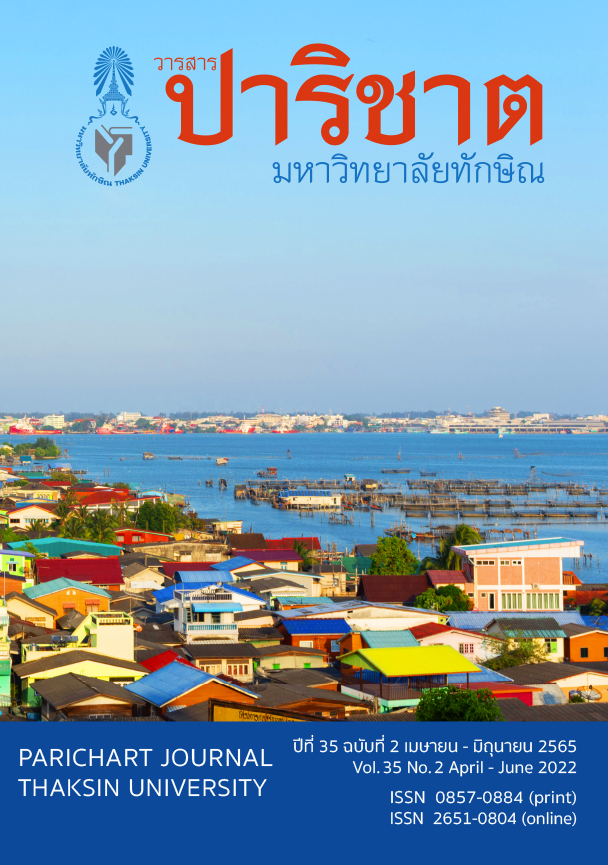พหุภาษาในเมืองชายแดนใต้ กรณีศึกษาภูมิทัศน์ทางภาษากับป้ายธุรกิจการค้าในเขตอำเภอเมืองยะลา จังหวัดยะลา
Main Article Content
บทคัดย่อ
การวิจัยนี้มีวัตถุประสงค์เพื่อศึกษารูปแบบภาษา3 บนป้าย และเพื่อวิเคราะห์รูปแบบการเขียน4 พหุภาษาบนป้ายในย่านธุรกิจการค้าอำเภอเมืองยะลาตามแนวคิดภูมิทัศน์ทางภาษา การวิจัยนี้ดำเนินการวิจัยด้วยเชิงคุณภาพจากกลุ่มตัวอย่าง คือ ป้ายร้านค้าที่อยู่ในตลาดย่านสายกลางยะลา โดยเลือกแบบเฉพาะเจาะจงที่เป็นป้ายสองภาษาขึ้นไปที่เห็นได้ชัดและเป็นป้ายถาวรจำนวน 50 ป้าย กล้องถ่ายรูปดิจิทัลและแบบบันทึกคือเครื่องมือเก็บข้อมูล ผลการวิจัยพบว่า ป้ายสองภาษาพบได้ในร้อยละ 54 บนป้ายร้านค้าธุรกิจการค้าปลีกและการค้าส่งเพื่ออุปโภคและบริโภคและธุรกิจด้านการบริโภค ส่วนป้ายหลายภาษาพบในอัตราร้อยละ 46 บนป้ายร้านค้าธุรกิจด้านเดียวกัน ส่วนรูปแบบการเขียนข้อความพหุภาษาบนป้าย ประกอบด้วย การแปลหรือทับศัพท์ การถอดความแบบผสมผสาน และการถอดความคนละความหมาย ผลการศึกษาดังกล่าวสะท้อนให้เห็นถึงความหลากหลายทางชาติพันธุ์ของผู้ประกอบการและผู้รับบริการในพื้นที่ และการยอมรับนโยบายภาษาจากผู้เกี่ยวข้องพร้อมกับปรับตัวให้ทันยุคโลกาภิวัตน์ด้วยภาษาอังกฤษ
Article Details

อนุญาตภายใต้เงื่อนไข Creative Commons Attribution-NonCommercial-NoDerivatives 4.0 International License.
เอกสารอ้างอิง
Sarot, T., & Kraisame, S. (2019). Urban multilingualism: A case study of the relationship between linguistic landscape and business in North Nana. Journal of Language and Culture, 38(1), (in Thai)
Wangpusit, K. (2012). Business names in the area of Siam Square: A linguistic landscape study. Master’s Thesis. Master of Arts. Bangkok: Graduate School, Chulalongkorn University. (in Thai)
Landry, R., & Bourhis, R. Y. (1997). Linguistic landscape and ethnolinguistic vitality. Journal of Language and Social Psychology,16(1), 23-49.
Gorter, D. (2006). Linguistic landscape: a new approach to multilingualism. Clevedon: Multilingual matters.
Pikulthong, S. (2011). Languages on commercial signs along Phra Athit Road. Master’s Independent Study. Master of Arts. Bangkok: Graduate School, Silpakorn University. (in Thai)
Backhaus, P. (2007). Linguistic landscapes: a comparative study of urban multilingualism in Tokyo. Clevedon: Multilingual matters.
Siwina, P., & Prasithrathsint, A. (2020). Multilingual landscapes on Thailand’s borders. Journal of Mekong Societies, 16(1), 112-131.
Sirisakdamkeong, P. (2003). The interrelationship between Malay Muslims and the Chinese in the market place, “Sai Klang”, in Yala province. Master’s Thesis. Master of Arts. Bangkok: Graduate School, Silpakorn University. (in Thai)
Cornish, A. (1997). Whose place is this? Malay rubber producers and Thai government officials in Yala. Thailand: White Lotus Press.
Huebner, T. (2006). Bangkok’s linguistic landscape: environmental print, code-mixing and language change. in Durk Gorter (ed.) Linguistic landscape: A new Approach to Multilingualism. Claverdon: Multilingual Matters. pp.3-51.
Meemongkong, K. (2020). Linguistic landscape of a university in Thailand. Journal of Liberal Art, Rangsit University. 15(2), 165-185. (in Thai)
Rhekhalilit, K. (2020). Language choice of public signage in Thai universities: a case study of Chulalongkorn University and Kasetsart University. Journal of Manutsayasa Wichakan 27(2). 310-341. (in Thai)
Songsiri, W. (2013). Concept of fundamental pluralism in multicultural Ruso: the diversity and friendship from the memory of the restricted area people. Najeeb Bin Ahmad. Bangkok: Lek-Prapai Viriyaphan Foundation. 9-13. (in Thai)
Piyasiripon, N. (2018). Multicultural communities in the midst of nationalism discourse in deep south of Thailand. The National Defence College of Thailand Journal. 60(2), 58-72. (in Thai)
Operational planning for developing tourism of southern border multicultural tourism area, (n.d.) Retrieved on August 7, 2021, from https://pattani.mots.go.th/download/article/article_20200407132742.pdf. (in Thai)
Cenoz, J., & Gorter, D. (2006). Linguistic Landscape and minority languages.” In Linguistic Landscape: A New Approach to Multilingualism, 67-80. Edited by Durk Gorter. Clevedon: Multilingual Matters.
Paolo Coluzzi. (2016). The linguistic landscape of Brunei. World Englishes Journal. 35(4). 497-508.
Rungswang, A. (2018). Linguistic landscape: forms and functions of signs in Thai community center, Golden Mile Complex, in Singapore. TNI Journal of Business Administration and Languages. 6(1). 35-40.
Ben Rafael, E., Shohamy, E., Amara, M.H., & Trumper-Hecht, N.: 2006, ‘Linguistic landscape as symbolic construction of the public space: The case of Israel’, in Gorter, D. and Cenoz, J. (2007). Knowledge about language and linguistic landscape. In Hornberger, N. (Ed.) Encyclopedia of Language and Education, 2nd revised Edition. (pp.1-13). Berlin: Springer Science.
Sirikhan, S. (2014). The preparation of Thai English teachers’ attitudes and empowering concepts concerning English As A Lingua Franca for ASEAN. FEU Academic Review Journal, 8(1). 46-60. (in Thai)
Spolsky, B. (2009). Prolegomena to a sociolinguistic theory of public signage. In E. Shohamy and D. Gorter (Eds.). Linguistic landscape: expanding the scenery. (pp.25-39). New York: Routledge
Scollon, R., & Scollon, S. W. (2003). Discourse in place: language in the material world. London: Routledge.
Kristof Savski. (2021). Language policy and linguistic landscape Identity and struggle in two southern Thai spaces. Retrieved on June 23, 2021, from https://www.researchgate.net/publication/349428640_Language_policy_and_linguistic_landscape_Identity_and_struggle_in_two_southern_Thai_spaces.


